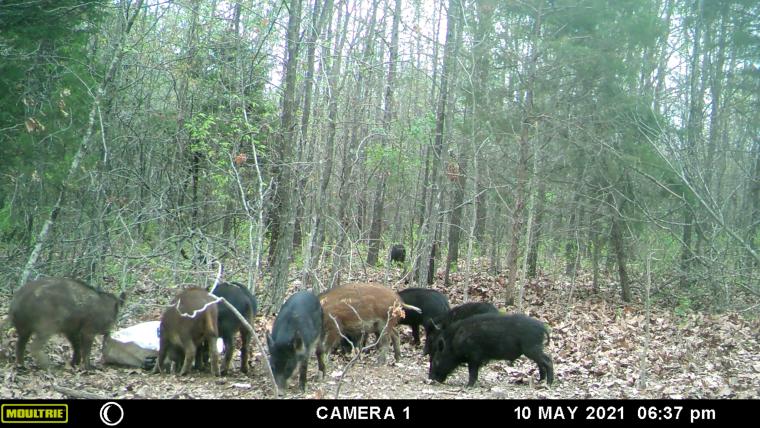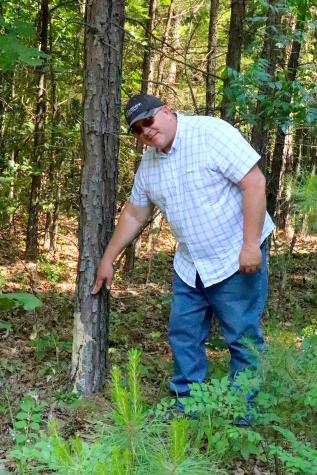Writer
Linda GeistSALEM, Mo. – Kevin Crider knows a troublemaker when he sees one, whether it be two-legged or four-legged.
Before joining University of Missouri Extension as a feral hog outreach educator, Crider spent 28 years as a Colorado state trooper and as a U.S. park ranger. He also was a Missouri Department of Conservation feral hog elimination specialist.When he moved back near his home area of Shannon County, he saw a growing need to root out wild hogs that were tearing up farm and forest land.
Crider’s work is part of the Missouri Feral Hog Elimination Partnership funded by the 2018 U.S. Farm Bill and managed by the Missouri Department of Conservation. More than 15 federal and state entities, including MU Extension, work together to eliminate feral hogs on public and private lands.
Educators like Crider work with landowners at meetings and one-on-one farm visits. There are 48 elimination specialists focusing on Missouri forests and watersheds, mostly south of Interstate 44.
Crider hopes to work his way out of a job by eradicating these invasive animals, which threaten Missouri’s vital hay, beef and forestry industries. Missouri ranks No. 2 in the nation in hay production and No. 3 in beef production. Southern Missouri also is home to many sawmills, stave and cooperage mills, log brokers and charcoal plants.
Numbers reduced by 65%
With the group’s help, feral hog numbers have decreased by nearly 65% in Missouri watersheds since 2016. In 2022, the partnership removed 6,289 hogs, helped 709 landowners and scouted 3.7 million acres, with efforts in Iron, Shannon, Wayne and Reynolds counties netting the most results.
It’s progress, but there is still much to do, says Crider. Feral hogs breed early and often. Sows can breed by 6 months of age and birth two litters of 6-12 piglets yearly.
Feral hogs can carry disease
Feral hogs can be aggressive, but they generally avoid humans. Their biggest threat is from spreading diseases like swine brucellosis to humans and livestock. People with brucellosis may develop endocarditis, a potentially fatal inflammation of the inner lining of the heart chambers. Signs of brucellosis include fever, sweats, headache, back pain and physical weakness.
Feral hogs also create roadway hazards since their beady eyes don’t reflect headlights. Adult hogs grow to 3 feet tall, 5 feet long and up to 400 pounds. Despite that, they can run 30 mph.
Feral hogs got a foothold in Missouri in the 1990s when wild game hunting gained popularity. They are found in 27 rural counties, mostly in southern Missouri.
Feral hogs become trap-shy and scatter
Trapping them is neither simple nor quick because they become trap-shy and scatter when threatened, says Crider. Pressured hogs can move to new areas and begin breeding all over again.
They hide under cover of dense forests and travel at night in herds called sounders. They root up ground in search of acorns, plant roots, earthworms and grubs. They tear up trees by rubbing their bristly-haired bodies on them; they can girdle smaller trees. Both male and female feral hogs have tusks, which they use for defense. The males also use them to establish dominance for breeding.
They make large wallows in moist areas and root up holes the size of truck tires in forests and pastures.
Elimination specialists survey woods with drones to find sounders, says Crider. They place cameras in the woods to track travel patterns and herd size. Trappers bait frequently visited areas. They hoist traps off the ground into trees. Sensors trigger the traps to fall and confine hogs.
During aerial operations on winter nights, trappers scout by drone. They use heat-sensing devices to spot hogs on the ground and mark their location with a GPS point. At daylight, a helicopter launches for aerial operations to destroy the hogs located by the drone.
Meat use is not recommended
Private landowners can process the hog’s meat, although this is not recommended because of possibility of disease. Trappers destroy hogs found on public lands and move the carcasses away from water drainage areas. Feral hogs eliminated on public lands may not be processed for human consumption.
Mark Twain National Forest, the National Park Service, Missouri State Parks, the Missouri Department of Conservation and the U.S. Army Corps of Engineers have closed public lands under their jurisdiction to feral swine hunting. In 2021, Missouri passed legislation making it illegal to transport, release or possess feral swine.
Equipment available to repair damaged fields
The group worked with Soil and Water Conservation Districts to purchase equipment to repair damaged fields. The equipment includes no-till drills, cultipackers and harrows and is available to borrow free of charge for repairing damage to make land productive again. Equipment is available for lease for other work as well.
To report feral hog damage or receive assistance, call the Missouri Department of Conservation at 573-522-4115 ext. 3296 or visit http://mdc.mo.gov/feralhog.
Funding for this work is through a Feral Swine Control Program (FSCP) through the USDA as part of the 2018 Farm Bill. Missouri Department of Conservation is the lead agency on the project.
Photos:
https://extension.missouri.edu/media/wysiwyg/Extensiondata/NewsAdmin/Photos/2023/20230921-fh-1.jpg
MU Extension feral hog outreach educator Kevin Crider points out where feral hogs have damaged trees. Hogs rub their bristly bodies on trees after wallowing in waterways. Photo by Linda Geist.
https://extension.missouri.edu/media/wysiwyg/Extensiondata/NewsAdmin/Photos/2022/20220314-fh-1.jpg
Feral hogs caught on camera at a bait site on private land in Crawford County. Photo courtesy of Kevin Crider.
https://extension.missouri.edu/media/wysiwyg/Extensiondata/NewsAdmin/Photos/2022/20220314-fh-2.jpg
Rooting damage from feral hogs at a golf course in Viburnum, Mo. Photo courtesy of Kevin Crider.
https://extension.missouri.edu/media/wysiwyg/Extensiondata/NewsAdmin/Photos/2022/20220314-fh-3.jpg
Traps like this one can catch an entire sounder of hogs all at once. Photo courtesy of the Missouri Department of Conservation.

